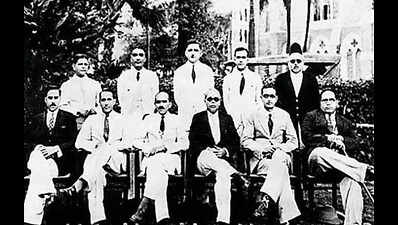Among the many memorabilia that decorate the principal’s chamber at the 180-year-old Govt Law College near Churchgate station, three photographs stand out: two of Bhimrao Ramji Ambedkar, also known as Babasaheb Ambedkar, and a picture of Gautam Buddha. We do not know how old these photographs are. However, exactly 90 years ago, on June 1, 1935, Ambedkar became the principal of this iconic college for two years, long before he was made the chairman of the drafting committee of the Constitution. The rest, as they say, is history.Barring Principal Asmita Adwait Vaidya and a handful of the staff, the usually bustling college campus is empty because of the summer vacation. “There are 2,200 students in the three courses we offer (LLB three-year, five-year, and LLM). We are the first law college in Asia and have produced a galaxy of alumni who became famous jurists and public figures,” says Principal Vaidya with pride.She says the college will commemorate the completion of 90 years of Ambedkar’s appointment as its principal after the vacation. They plan to invite Bhushan Ramkrishna Gavai, Chief Justice of the Supreme Court, to be the chief guest at the event. “Gavai did his first year of LLB here before he moved to Nagpur University,” says the principal. “So he too is our alumnus.” Among other noted alumni are freedom fighter Bal Gangadhar Tilak, former President Pratibha Patil, and many jurists and legal eagles. Joining the commemorative function will be Rajendra Jadhav of the think tank ‘Borderless Babasaheb’. “Babasaheb’s appointment as principal of this prestigious college carried a huge significance in the annals of Dalit empowerment in India. The event deserves commemoration,” says Jadhav.The year 1935 was significant to Ambedkar for other reasons too. Four days before he became the Law College’s principal, on June 1, 1935 (economist and author Narendra Jadhav insists it was June 2, while some other sources, including an author and MP in his book on Ambedkar, say it was June 1), Ambedkar’s wife Ramabai died. Ramabai’s death devastated Ambedkar. Enduring privation, and the loss of four children, she suffered immensely. Ambedkar documented her resilience as someone who “did not flinch from carrying a basketful of cow dung on her head during periods of financial distress.” Mourning her death, Ambedkar wrote that he “could not find even half an hour in 24 hours for this extremely affectionate and venerable wife.” He dedicated his book Pakistan or the Partition of India to Ramabai, or Ramu as he called her.Narendra Jadhav, who has penned over two dozen books on Ambedkar, says this was a period of lull for Ambedkar. “He was teaching at the Law College off and on. He never had a roaring practice at Bombay High Court, and he was made the principal because of his stellar qualifications and passion for teaching,” says Jadhav.In a newspaper article Vaidya wrote on December 6 (Ambedkar’s death anniversary) last year, she says: “His passion for teaching was immense. Though he taught law, his subjects went beyond textbooks. He guided students in subjects like economics, politics, sociology, and history, offering a multidimensional view of learning.”It was in 1935 when Ambedkar expressed his intention to convert to another religion. At the Depressed Classes Conference of October 1935 (called Dalit Vargiya Parishad in Marathi; Tharoor claims it was one of the first public uses of the term ‘Dalit’), Ambedkar recounted the humiliations and injustices heaped upon the Dalits for centuries. He told his people to consider converting to another religion that would consider them as equal.“Babasaheb led from the front and declared that he was unfortunately born a Hindu untouchable but asserted that he would not die a Hindu,” says Jadhav. He fulfilled that pledge on October 16, 1956, in Nagpur when, along with half a million followers, he embraced Buddhism.






